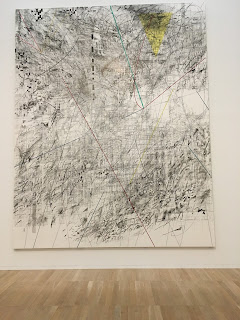Tate Modern
My first
(fleeting) visit to the Switch House. I visited the “Living Cities” display . The first room curated photographs by the
Finnish artist Sirkka-Liisa Konttinen, who photographed Byker in Newcastle in the
late 1960s and 1970s. The black and white back to back photographs are
incredibly evocative and show an area that is poor but very vibrant. They
underlined to me the importance of capturing these glimpses of the everyday of
yesteryear; demolition, buildings gone forever, time gone forever, the minutiae
of everyday life. What happened to those people whose homes were demolished?
Where did they go? The children she photographed must be around the same age as
me. Where are they now?
 |
| Julie Mehretu : Mogamma, A Painting in Four Parts: Part 3 |
The second,
larger, room, contained two works of particular interest to me. The first was
by Julie Mehretu, an artist I’d not come across before. Her “Mogamma, A Painting in Four Parts: Part 3” is a narrative around protest and
political unrest. The precise architectural drawings of the Mogamma (the Egyptian
government building) are partly obscured with shapes and images from other
sites of public unrest. The other one was “Los Moscos” by Mark Bradford , again an artist new to me. This work
takes materials found on the street around his studio in Los Angeles and create
a kind of map of the (an?) urban area. The entire work is constructed from paper
fragments.
 |
| Mark Bradford : Los Moscos |
Both of these
works depict place, but quite differently. Mehretu’s layering comes across as
quite direct; figurative images of a definite place are obscured by marks that
could be maps or leaves or footprints, or any one of a number of other things.
Bradford’s work gives a more abstracted sense of place that could be any big
city. The effects of the two are quite different. Methretu’s work is almost
understated compared to Bradford’s, with the latter’s dark colours punctuated
by neon brights. For me there was a direct resonance with the previous day’s
crit – trying to depict a place or a journey without being too literal. Mehretu
has mixed figurative and abstract. Bradford has used found paper and based his
piece on the shock value of the colour he’s used. What can I take from these? Objects,
layering, figurative, abstract. Bradford’s assemblage technique. Moving away
from the obvious. Both works are fragmented – this term keeps coming up again
and again and I need to think about how it could work for me.
White Cube, Bermondsey
Two very different
exhibitions here, again by two artists new to me.
 |
| Ibrahim Mahama : Crop Estate |
Ibrahim Mahama’s
exhibition is titled Fragments – that
word again. It contains huge wall hangings created from used cocoa sacks and
tarpaulins from the artist’s native country, Ghana. The immediate effect is
quite dark and depressing, but after a few minutes of reflection the work
begins to appear more nuanced and detailed. For me, it deals with decay,
leaving behind the past – not dissimilar to some of the themes in Konttinen’s
work. The works also smell foisty. This is an intrinsic part of the materials
and this was the first time I’d ever know an art work to smell – and for the
smell to effectively form part of the narrative. Another room contains the
installation “Non-orientable Nkansa” - masses of shoe-shine boxes. I’m not
clear if these are genuine items or if they’d been constructed for the –
sculpture? Installation? I’m also not clear if this is art. It seemed to more
like political comment – but then art is about commentary. Whatever, it must
have taken an awful lot of effort to balance it, both politically and
aesthetically.
 |
| Ibrahim Mahama: Non-Orientable Nkansa |
There was a lot to
take in with these works; colours, textures, smells. Re-purposing of objects.
Transience – time, people. Objects from another country, another culture. The
gallery handout (White Cube, 2017.) also points to investigations into
capitalism and trade transactions. I liked the sacks; the texture, colour,
darkness (a metaphor for economic corruption?), the stories they could tell,
the stories they did tell. The evocation of hidden narratives. The fact that
the sacks are sewn together irregularly, with holes. Interestingly, Mahama
calls the sack works “paintings”.
 |
| Josiah McElheny: Crystal Landscape Painting (Rocks) |
Drawing Room
 |
| Piece by Sonia Boyce |
What to take from the day
Artworks come in
all shapes, sizes, colours, media. I take this as an affirmation to continue
with what I’m doing and follow my own aspirations. Temporality, fragmentation,
place, experiences, narratives – these themes are of concern to many artists.
In writing this post the concept of fragmentation
keeps recurring and I need to take this on board.
No comments:
Post a Comment